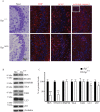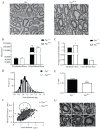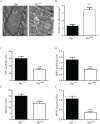Motor and Sensory Deficits in the teetering Mice Result from Mutation of the ESCRT Component HGS
- PMID: 26115514
- PMCID: PMC4482608
- DOI: 10.1371/journal.pgen.1005290
Motor and Sensory Deficits in the teetering Mice Result from Mutation of the ESCRT Component HGS
Abstract
Neurons are particularly vulnerable to perturbations in endo-lysosomal transport, as several neurological disorders are caused by a primary deficit in this pathway. In this report, we used positional cloning to show that the spontaneously occurring neurological mutation teetering (tn) is a single nucleotide substitution in hepatocyte growth factor-regulated tyrosine kinase substrate (Hgs/Hrs), a component of the endosomal sorting complex required for transport (ESCRT). The tn mice exhibit hypokenesis, muscle weakness, reduced muscle size and early perinatal lethality by 5-weeks of age. Although HGS has been suggested to be essential for the sorting of ubiquitinated membrane proteins to the lysosome, there were no alterations in receptor tyrosine kinase levels in the central nervous system, and only a modest decrease in tropomyosin receptor kinase B (TrkB) in the sciatic nerves of the tn mice. Instead, loss of HGS resulted in structural alterations at the neuromuscular junction (NMJ), including swellings and ultra-terminal sprouting at motor axon terminals and an increase in the number of endosomes and multivesicular bodies. These structural changes were accompanied by a reduction in spontaneous and evoked release of acetylcholine, indicating a deficit in neurotransmitter release at the NMJ. These deficits in synaptic transmission were associated with elevated levels of ubiquitinated proteins in the synaptosome fraction. In addition to the deficits in neuronal function, mutation of Hgs resulted in both hypermyelinated and dysmyelinated axons in the tn mice, which supports a growing body of evidence that ESCRTs are required for proper myelination of peripheral nerves. Our results indicate that HGS has multiple roles in the nervous system and demonstrate a previously unanticipated requirement for ESCRTs in the maintenance of synaptic transmission.
Conflict of interest statement
SMW is a paid consultant for Progenra Incorporated. This does not alter the authors’ adherence to any of the PLOS Genetics policies on sharing data and materials, and it does not influence the generation or presentation of the data.
Figures











References
-
- Clague MJ, Urbe S (2001) The interface of receptor trafficking and signalling. J Cell Sci 114: 3075–3081. - PubMed
Publication types
MeSH terms
Substances
Grants and funding
LinkOut - more resources
Full Text Sources
Other Literature Sources
Molecular Biology Databases
Research Materials

